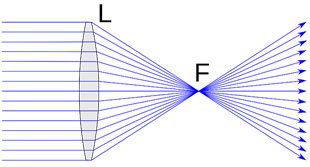AIM
Finding the Image distance for varying object distance in case of a convex lens and drawing corresponding ray diagrams to show the nature of Image formed by a convex lens.
MATERIALS REQUIRED
A thin convex lens, a lens holder a piece of a semi-transparent sheet act as screen fixed to a stand with the centred mark; a small candle end stand for candle with centred mark and a meter scale (or a ruler)
THEORY
The light ray when refracted through a thin convex lens follow the law of refractions.
The formation of an image by lenses can be described using the new cartesian sign convention.
The new cartesian sign convention can be summarised as below:
(i) The object is always placed to the left of the lens.
(ii) All distances parallel to the principal axis are measured from the optical centre of the lens.
(iii) All distances measured to the right of the origin are taken as positive while those measures to the left of original taken as negative.
(iv) Distance measured perpendicular to and above the principal axis are taken as positive.
(v) Distances measured perpendicular to and below the principal axis are taken as negative.
The position, nature and size of the image of an object formed by s thin convex lens depend on the distance between the object and the optical centre and size of the object.

The nature, position and size of the image can be noted, and distance is measured from the optical centre of the convex lens.
PROCEDURE
1. Place the semi-transparent paper screen in a vertical position fitted to a stand on the right-hand side of the convex lens.
2. Place a thin convex lens vertically on the lens holder.
3. Place the candle in a centred mark stand on the optical bench.
4. Place the lighted candle stand at a distance beyond R(2F1) vertically in the front of a thin convex lens.
5. Adjust the height of the centre of the convex lens to be equal to the height of the flame of the candle as shown below.

6. Obtain a sharp image of the candle flame on the screen
7. Using measuring scale, record the position of lens and screen in the observation table.
8. Repeat the experiment by placing the lighted candle at a distance as given below:
(i) equal to 2F
(ii) less than 2F but more than F.
9. Find the distance between the optical centre of the lens and candle flame (object) to be x and corresponding image distance between the optical centre O of the lens and the screen be y.
10. Draw corresponding ray diagrams in each case to show the nature of the image formed by a convex lens.
OBSERVATIONS AND CALCULATIONS
The approximate focal length of the thin convex lens, F = 10 cm
The height of the candle flame, h = 2 cm.

S. No. |
The position of lens ‘l’ (cm) |
The position of candle ‘c’ (cm) |
The position of screen ‘s’ (cm) |
Distance between lens and candle x = (l – c) (cm) |
The distance between lens and screen y = (s – l) (cm) |
Image height h’ (cm) |
Magnification h/h.’ |
1. 2. 3. 4. 5. |
30 cm 30 cm 30 cm 30 cm 30 cm |
5 cm 8 cm 12 cm 15 cm 18 cm |
47 cm 48.5 cm 52.5 cm 60 cm 90 cm |
25 cm 22 cm 18 cm 15 cm 12 cm |
17 cm 18.5 cm 22.5 cm 30 cm 60 cm |
1.35 cm 1.68 cm 2.5 cm 4 cm 10 cm |
0.68 cm 0.84 cm 1.25 cm 2 cm 5 cm |
RESULT
When the object is moved from infinity towards the optical centre of the convex lens.
(a) the image distance increases gradually.
(b) the size of the image also tosses gradually.
PRECAUTIONS
1. The base of the candle stand, convex lens and the screen must be parallel to the measuring scale.
2. The lens should be held vertically inside the lens holder.
3. Flame of the candle must be uniform and continuous throughout the experiment.